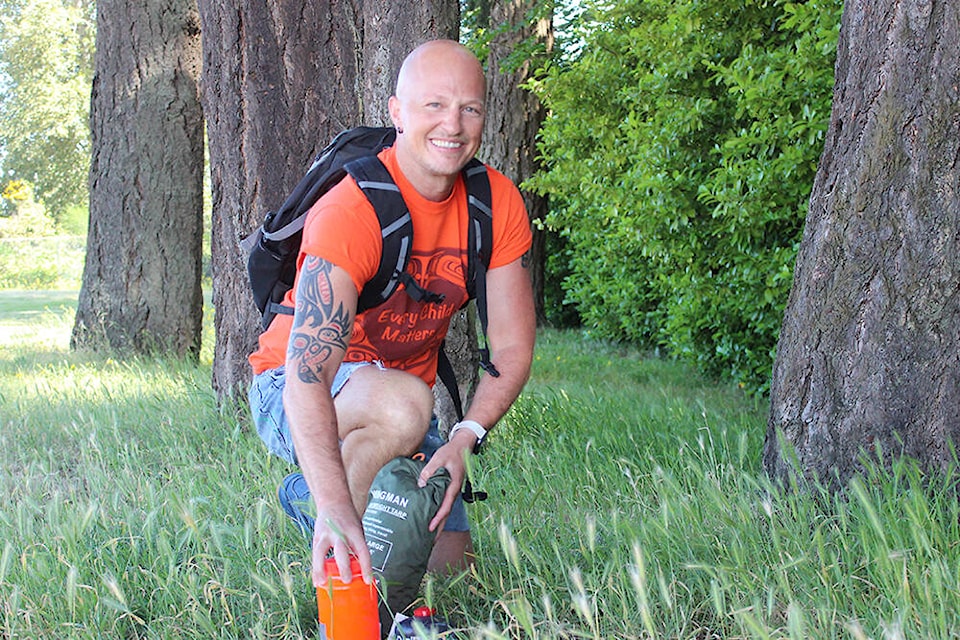A non-traditional curriculum, with outdoor learning and mental health support, has helped vulnerable students stay engaged in their education.
The Take a Hike program, a partnership with Nanaimo Ladysmith Public Schools and non-profit Take a Hike Foundation, operates out of the district learning alternatives school and utilizes outdoor recreation to help Grade 10-12 students immerse themselves in their education and their community.
Brett Hancock, learning alternatives principal, said the program typically has 30 students and seeks to improve physical and mental well-being. Participants are on the same Dogwood diploma graduation path as other students, enrolled in eight courses, with staff tailoring learning standards of science, math and English “into a project-based learning opportunity” that takes place off-campus. It’s worth a substantial amount of students’ grade and geared toward something students care about, he said.
The district provides two full-time teachers and a child youth and family support worker, while the foundation offers a full-time registered mental health clinician and a program manager. Students take part in land-based learning outside the classroom once a week, Hancock said.
“The big thing with Take a Hike is improving the levels of mental health and well-being in our students and the first thing is just creating safe and caring relationships in an environment that’s safe and predictable…” he said.
He said the program involves an overnight activity early in the year before fall weather gets too unpredictable, when students receive individualized support, and there is also some “intensive time” where students are learning alongside staff and classmates.
“We find once you step out of the school building and the into nature, it’s an opportunity for students to drop their guard a little bit and start to attend regularly, engage in the activities and develop trust and relationships with staff,” Hancock said.
William Watt, youth support worker this past school year, said students benefit from immediate support should they suffer anxiety or other issues.
“When you create a relationship with a student, and you get to know them, then you get to know their signs and their little signals that they’ll set off…” he said. “Somebody like myself, or staff, or [the counsellor] will see that and then gently [say], ‘Hey, would you like to go for a walk?’ and get them out of the environment and then be able to support them on feeling more comfortable, and then slowly transitioning back into the classroom again, or whatever they need.”
Hancock said Take a Hike students become better at effectively coping with stress.
“They become far more resilient, especially given the times of going through a global pandemic, and a lot of uncertainty and a disengagement from school, a lot of people trying distance learning and not having a great deal of success … this program is very good at helping them effectively deal with it with different strategies and through time in nature,” said Hancock. “Our graduates, I’m confident, are able to navigate tasks of young adulthood and for furthering their education.”
Students did not wish to be interviewed, but some talked to Bill Robinson, school trustee, about the benefits of the program. One said she was struggling and in a bad place and not attending school, but after connecting with the program and peers facing similar difficulties, she found stress relief in the field trips and built bonds with teachers. She now has a better understanding of her learning difficulties and how to cope with her emotional and mental struggles, according to Robinson.
Charlene Smith, Take a Hike manager of philanthropy for Vancouver Island, said the program saw an all-time high this past year with 97 per cent graduating.
Nanaimo-Ladysmith was the first school district on Vancouver Island to offer the program, with Cowichan Valley and Saanich also offering the program. Sooke, Westshore and Stz’uminus First Nation will begin offering it this coming school year.
READ ALSO: SD68 learning alternatives awarded $8K tech grant
reporter@nanaimobulletin.com
Like us on Facebook and follow us on Twitter
